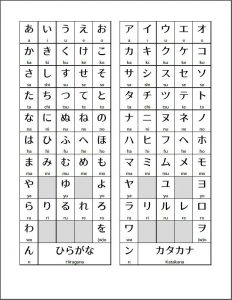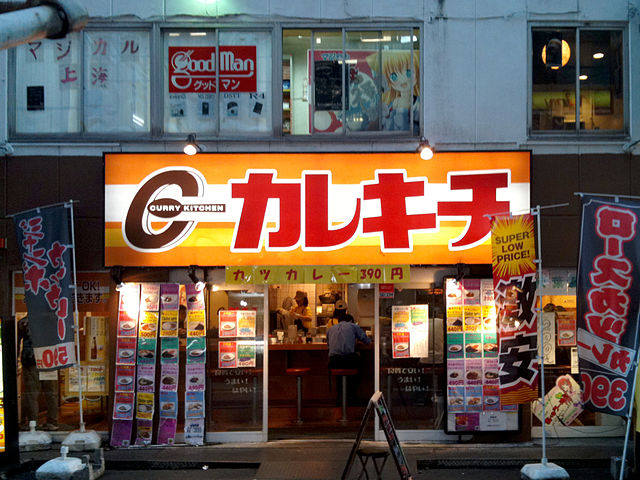Learning how to speak Japanese and learning how to read it are two totally different stories! For the most part, the speaking part is a lot more fluid and flexible with the rules of grammar than the written part is.
What is the Japanese alphabet you ask? Well technically speaking, Japanese doesn’t actually have an Alphabet. What it has are two Scripts (Hiragana and Katakana) and Kanji (Chinese characters).
If you want to know how to read Japanese and be considered literate, then you’ll have to learn all three of them. Let’s take a closer look into each one now!
Hiragana – ひらがな

The English alphabet is composed of 26 letters (A through Z) and each one represents a single phonetic sound. However, none of them represent any sort of meaning.
The first Japanese script is called hiragana ひらがな. It is comprised of 46 basic “kana” and each one can represent either a single vowel/consonant or a combination of one consonant and one vowel.
The following hiragana are the exact ones used to spell the word. Notice that each one of these represents the combination of a consonant, followed by a vowel.
- ひ = hi
- ら = ra
- が = ga
- な = na
There are a total of five different vowels in Japanese and their sounds never change. If you’d like to learn more on how to speak Japanese, then click on this link to read about it.
Here are some examples of hiragana that represent only one vowel:
- あ= a
- い = i
- う = u
- え = e
- お = o
Hiragana is characterized by its curvy lines. It is very beautiful to look at when written in calligraphy. It’s primarily used for grammatical reasons or for words that don’t have any kanji associated with it.
Here is a chart that you can download and print out to help you learn all the basic hiragana and katakana. For now, just focus on the hiragana on the left side.
*Click on the picture below to download*

There are several different methods that you can use to learn hiragana:
(1) – Probably the most common way is simply to pick a row of five hiragana and write them out on a piece of paper 10 times. Then add a new row of five to the mix and repeat the process with all of them. Keep on doing this until you’ve got them all memorized.
This is actually how I learned to write and memorize hiragana. A lot of people don’t like this method, but I thought it was pretty cool to be able to write in Japanese and understand what it meant. I could look and it afterwords and say, “Yeah! I did that!” Using this method took me about a day or two to learn them all.
(2) – Apps or online games are also a great way to learn them. I actually have a game on Steam that teaches you hiragana in the format of a Japanese Role Playing Game (JRPG).
What’s great about using games to learn is that you have a lot of fun while doing it, so learning becomes a very natural process.
By the way, this process of learning by messing around with it, checking it out, and enjoying it, is primarily how children learn new things when they’re young.
(3) – Mnemonics. There are a several different blogs out there that have created a specific mnemonic (learning device) for each hiragana. Usually they will take a single hiragana and show you a picture of something that looks similar to it that you are already familiar with and then link the two so that when you see the hiragana again, the linked memory is triggered and you remember how to pronounce the hiragana correctly.
It may sound complicated, but it’s actually quite simple simple once you try it. For example, the hiragana “ん” actually looks very, VERY similar to the English “n” and they are pronounced exactly the SAME way!
Presto! That’s a mnemonic!
Now that you’ve explored hiragana, let’s move on to the second script for Japanese: katakana!
Katakana – カタカナ

|Image credit: Wikimedia Commons|
The second script is called katakana カタカナ
The good news is that the 46 basic katakana are pronounced EXACTLY THE SAME as the hiragana ones! The bad news it that you still have to learn them 🙁
It shouldn’t come as too much of a shock as to why there would be more than one symbol for the same sound. Just look at upper case and lower case letters in English. Each one serves a different function!
- な = na (hiragana)
- ナ = na (katakana)
Likewise, katakana has its own special rules and uses. Katakana is mainly characterized by its angular lines, as opposed to hiragana’s curvy ones. This gives katakana a “cool” look and it is often used in manga and anime for that reason. But, it’s primarily function (or use) is for loan words.
Want to write the Japanese word for hamburger? It is ハンバーガー (pronounced: ham-baa-gaa) and you would use katakana for it, not hiragana.
Another thing to note is that since katakana is not used nearly as much as hiragana and kanji in writing, it has a certain quality that JUMPS out and grabs your attention when you see it! Because of this, manga artists will sometimes use it to write the names of the characters in the story.
All the same strategies used to learn hiragana can also be used to learn katakana. Refer back to those three suggestions earlier if you can’t remember what they are.
Now, go back and take a look at that kana chart again, this time looking at the katakana on the right side.
…
Go ahead, I’ll wait 🙂
…
Remember when I said these were the basic kanas? Yeah… basic.
But wait! There’s more!!!
Non-Basic Kanas
You may have noticed some missing sounds from the last two charts. That’s because all of the following kana that you will learn are constructed by modifying the basic ones, ever so slightly. Let’s take a look and see how.
Dakuon are super easy to use and understand. Basically, you just add two dashes to the top right of the kana in order to change the consonant from its unvoiced version, to its voiced version. There are only four that this rule can be used with. Onces that start with a (k, s, t, or h). Here are the examples for hiragana:
- か “ka” becomes “ga” が
- さ “sa” becomes “za” ざ
- た “ta” becomes “da” だ
- は “ha” becomes “ba” ば
Now what do I mean by “voiced” and “unvoiced” consonants? See for yourself!
- Take your hand and lay it over the front of your throat .
- Now make the sound “ssssssssss” kind of like a snake hissing.
- Now make the sound “zzzzzzzzzz” kind of like a bee buzzing.
Did you notice the difference? You should have felt a lot of vibration with the “zzzzz” that weren’t there with the “sssss” This is what I mean by “voiced” and “unvoiced” sounds.
Handakuon (no this isn’t Street Fighter!) are even easier. All you do is write in a small circle instead of those two dashes. And you only use them to change “h‘s” into “p‘s”
- は “ha” becomes “pa” ぱ
Yōon are like a combination of two kanas that are used to create a single new one. You take a kana that uses any consonant + “i” vowel and combine it with (ya, yu, or yo).
The way you write it is by making the (ya, yu, or yo) really small and right next to the “consonant + ‘i’ vowel.” Here are three examples:
- き + や = きゃ (ki + ya = kya)
- り + よ = りょ (ri + yo = ryo)
- し + ゆ = しゅ (shi + yu = shu)
Sokuon is the last one, but certainly not the least! It’s just used to represent the “stop sound” in Japanese. You just take the つ tsu symbol and make it smaller.
まって (matte) = wait
I know, I know… that’s A LOT to take in all at once! And you still have to learn about kanji too!
Kanji – 漢字

The third and final part of written Japanese is kanji 漢字
- 漢 = kan (Han Chinese)
- 字 = ji (Characters)
Kanji are ideograms (pictures) borrowed from Chinese. Each kanji represents an idea, and sometimes several. Once you learn a certain amount of Kanji, you can start to guess at the meaning of new ones you encounter based on what you already know.
Unfortunately though, there is no one sound per kanji like there is with hiragana and katakana. Usually there are several different sounds for each kanji depending on how it’s used.
Here are a few kanji examples. Can you guess the meaning of each one based on how it looks?
- 山
- 川
- 火
- 木
If not, don’t worry about it! You see, originally the Chinese drew pretty good pictures of what each symbol represented. Then as time went on, it became necessary to make all of the symbols fit next to each other on paper in a way that worked well.
In order to do this, the Chinese “squared” them all off. Now they fit together a lot better, but it is sometimes hard to tell what they are just by looking and guessing. By the way, here are the meanings of those earlier kanji:
- 山 = mountain
- 川 = river
- 火 = fire
- 木 = tree
There are over 50,000 different kanji in existence! But luckily, you only need to learn about 2,000 of them to read 99% of all Japanese books and manga.
The best way to learn kanji is to find a system or program that uses mnemonics in a very structured way. One that will allow you to progress from kanji to kanji in a logical progression.
Once you’ve gotten a pretty good handle on hiragana, katakana, and some kanji, the best way to learn to read is simple: Read! Read a lot!
In all seriousness, the main way to become a good reader in English is to read things that interest you and to read them often. Japanese is the same way. Of course you have to have a basic knowledge first, and now you do!
Resources for further learning
If you would like any recommendations for further help on leaning to read hiragana, katakana, and kanji, then here they are below. These are the things that I used:
Was that helpful? How did YOU learn to read Japanese? Leave a comment below and let me know!
Further Resources for Learning Japanese:
#3 Get My eBook (Secrets to Learning Japanese) for Free

またね!

Hey Nick
Very exciting! I did enjoy reading your article about Japanese alphabet – and I had no idea it is so comprehensive! Some time ago I watched a broadcast on Japanese language and the only thing I remember was them saying that one symbol can mean a sentence or even a short story. And that you can learn this language for the whole life and still you couldn’t say you know it for 100% 🙂 Sounds really challenging!
I read that you have been learning Japanese for 5 years – do you feel now confident with reading and talking in Japanese? Or do you rather feel you have just started and there is still a long way to go?
Hey Arta, I’m happy you enjoyed the post!
I’m pretty confident when it comes to speaking and reading Japanese. I do still have to look up new words when I come across them, but it’s one of those things where the more you do it, the better you get and the more confident you feel about it all.
I have made some Japanese friends in the last few days and they also have a hard time speaking English.
I am thinking of studying the Japanese alphabet to communicate with them. This article comes right on time! Maybe I need to start with reading and writing, even just the basics if I could.
Thanks Nick.
You are welcome! 🙂
Yeah, English is notorious around the world for being hard to learn. There’s a lot of irregularities with the rules of grammar and pronunciation. So learning some Japanese to communicate with you friends is pretty cool! Glad I could help!
This is great, thank you! I’m currently living in Okinawa Japan and I’m always looking for great resources to use with my family for learning Japanese that are easy to use and retain-able (if that’s a word…). Every time we go to dinner or shopping in town we look to learn something new. However, it’s mostly been in the speaking realm. This has motivated me to start looking into reading moreso than I have been in the past. I really appreciated your suggestion about using games to learn, that hits home the most. Keep up the great work!
Hey thanks Howard, I’m glad I could help! That’s pretty awesome that you and your family are living in Okinawa, what a great opportunity!
I have a Japanese manga that was given to me as a present that I’d like to be able to read it. Some of the characters look like Hiragana and others look like Katakana but I’m still not sure. Is it possible for both styles of writing to be used in the same script?
Yeah some of the hiragana and katakana look almost identical. Like the kana for “KA” only has one tiny difference between the two scripts:
か – Hiragana
カ – Katakana
Hiragana is used a lot more, so probably the majority of it is that with the occasinal word in katakana.
I found this article really helpful.
I had followed a course about Japanese calligraphy and spent several lessons copying ideograms on big sheets. Now I discover that they were just kanji and there are other three different alphabets!
Now I feel like I have a better understanding about how it works.
Do you think I could continue learning kanji by myself? My Japanese teacher was in Belgium and now I’m back in Italy. But I still have all the materials and could integrate them with the tools you suggest.
I was also comparing what you wrote to learning Arabic and the use of Dakuon dashes in order to change the consonant from its unvoiced version, to its voiced version. In Arabic it’s very similar even if the symbols to add are different.
Hey that’s pretty awesome! I didn’t know that about Arabic. I always think it’s pretty cool when you learn something in one language that is very similar or identical in another.
And you can definitely continue to learn kanji on your own. There are a ton of great resources out there to help you depending on what your goals with it are. I wrote a post some time ago specifically about learning kanji. If you’re interested, then check it out with the link below!
https://japanesetactics.com/how-to-learn-kanji-the-easy-way
Oh boy, the Japanese alphabet is hard. I remember when I first decided I wanted to learn Japanese, I thought it would be difficult learning all the kanji… but little did I know that there were four alphabets!
This is such a useful page for me, having everything laid out and explained–I’ve bookmarked it for future reference–and the rest of the site looks awesome for helping me speed up my (somewhat slow…) progress so far 🙂
Yeah, it is totally different from the Alphabet that we know and use everyday! Even the Japanese have a hard time with Kanji sometimes, lol.
I’m glad you like the site! Check out the difference resources to help with your studies! 🙂
HI, Nick.
I found this article really helpful. I used to think the written Japanese language looked like mutated stick figures, but now I feel like I have a basic understanding.
Do you think I could learn 2,000 kanji by using flash cards? I know it would be a lot of cards to keep track of but I figure I could upload them into a gallery on my laptop and flip through them every day.
Thanks,
Kalie
Hey Kalie, I’m glad you found it useful!
Yes, you can definitely learn 2,000 kanji using flash cards! There are a lot of free programs already out there that do just that. I personally use an app on my iPhone called “anki”
You might want to check it out. You can download decks of kanji flashcards that other people have already created. It uses an advanced technique called the Spaced Repetition System. That’s a fancy name, but it means that the cards you have a harder time with will reappear more often than the easy ones.
Good luck!